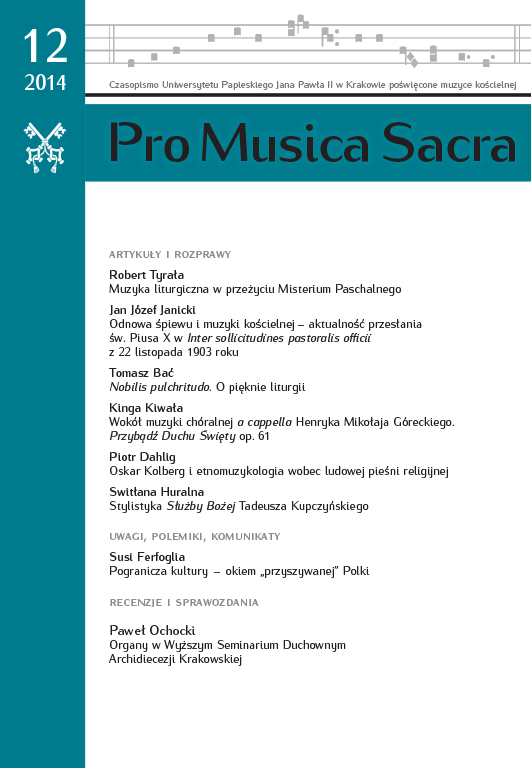Experience and evolution of the Greek ideal of beauty in the concept of Pseudo-Dionysius the Areopagite. Musician as a humble hymnist
DOI:
https://doi.org/10.15633/pms.1515Keywords:
Plato, Plotinus, Pseudo-Dionysius the Areopagite, Beauty, the Goodness, the Truth, philosophy, Christianity, art, music, ideaAbstract
Beauty, as one of the key concepts of classical philosophy and affirmed by Christianity, is subject to further evolution. In its hierarchy, as Plato stressed, it rises from the physicality through actions and laws up to the truth that reveals beauty in and of itself – unchanging and eternal. Plotinus believed in the beauty of things from their presence in the ideal, which is true Oneness. Higher areas of beauty can be seen only by the soul. The culmination of Beauty as recognized Plotinus is the highest Beauty and the supreme Good in itself that gives everything and loses nothing. According to the theory of emanation, beauty also passes into deeds and cultivated activities, especially art, which as a tool portrays and reveals the essence of things. Participation in giving form to eternal beauty is possible because a man, an artist, has a vision of eternal ideas. Plotinus established a hierarchy of those, who because of their predispositions are able to advance and discover the beauty of the divine mind: musician – aficionado – philosopher. This three-stage initiation was transformed by Pseudo-Dionysius into the concept of the celestial hierarchy and the Church hierarchy. Together, they form the way to know God’s Truths. Highest beings receive the doctrine of God’s miracles by means of illumination. Next, they pass it down to the lower hierarchies so that they can glorify and receive God according to their predispositions. In this way, says Dionysius, the texts of the Bible provide the people with hymns, sung by the angels of the highest hierarchy in which was revealed the greatness of their extraordinary light. Hymns and canticles which are sung by the Church are a reflection of the spiritual hymns from the celestial hierarchy. According to Dionysius, any other being participates in beauty because it comes from God, and therefore it can become a source of the most profound contemplation. The concept of Plotinus implies breaking down barriers in the quest to catch a glimpse of beauty, suitable to lead both the musician, the artist, and the lover, so that they can see the true beauty. For Dionysius, the musician is a recipient and utterer of the beauty which is contained in the eternal, heavenly hymns. His faith makes him a tool of God, and he becomes a humble hymnist.
References
Arystoteles; Etyka nikomachejska; tłum. D. Gromska; Warszawa 1956.
Atanazy Wielki; Przeciw poganom; tł. wstęp i oprac. M. Wojciechowski; Warszawa 2000 (Pisma Starochrześcijańskich Pisarzy; 62).
Augustyn; św.; O nieśmiertelności duszy; [w:] św. Augustyn; Dialogi filozoficzne; Kraków 2001.
Bazyli Wielki; Homilia na Hexaemeron; [w:] Antologia literatury patrystycznej; t. 2; tłum. M. Michalski; Warszawa 1975.
Dokumenty Soborów Powszechnych; t. 1; opr. ks. A. Baron; ks. H. Pietras; Kraków 2007.
Drączkowski F.; Patrologia; Pelplin–Lublin 1999.
Gadamer H. G.; Prawda i metoda. Zarys hermeneutyki filozoficznej; tłum. B. Baran; Kraków 1993.
Platon; Fajdros; tłum. W. Witwicki; Kęty 2002.
Platon; Fedon; tłum. W. Witwicki; Kęty 1999.
Platon; Prawa; tłum. M. Maykowska; Warszawa 1960.
Platon; Timajos; tłum. W. Witwicki; Kęty 2002.
Platon; Uczta; tłum. W. Witwicki; Kęty 2002.
Plotyn; Enneady I; V; przeł. A. Krokiewicz; Warszawa 2000.
Proklos; Elementy teologii; tłum. R. Sawa; Warszawa 2002.
Pseudo-Dionizy Areopagita; Hierarchia Kościelna; [w:] Pseudo-Dionizy Areopagita; Pisma teologiczne II; tłum. M. Dzielska; Kraków 1999.
Pseudo-Dionizy Areopagita; Hierarchia Niebiańska; [w:] Pseudo-Dionizy Areopagita; Pisma teologiczne II; tłum. M. Dzielska; Kraków 1999.
Pseudo-Dionizy Areopagita; Imiona Boskie; [w:] Pseudo-Dionizy Areopagita; Pisma teologiczne; tłum. M. Dzielska; Kraków 2005.
Pseudo-Dionizy Areopagita; Pisma teologiczne. Imiona boskie. Listy; tłum. M. Dzielska; Kraków 1997.
Stróżewski W.; Wokół piękna; Kraków 2002.
Tatarkiewicz W.; Historia estetyki; t. 2; Warszawa 2009.
Tomasz; św.; Suma teologiczna; tłum. o. P. Bełch; Londyn 1960.
Downloads
Published
Issue
Section
License
Authors who publish with this journal agree to the following terms:
- Authors retain the copyright and full publishing rights without restrictions, and grant the journal right of first publication with the work simultaneously licensed under a Creative Commons Attribution 4.0 International License that allows others to share the work with an acknowledgement of the work's authorship and initial publication in this journal.
- Authors are able to enter into separate, additional contractual arrangements for the non-exclusive distribution of the journal's published version of the work (e.g., post it to an institutional repository or publish it in a book), with an acknowledgement of its initial publication in this journal.
- Authors are permitted and encouraged to post their work online (e.g., in institutional repositories or on their website) prior to and during the submission process, as it can lead to productive exchanges, as well as earlier and greater citation of published work (See The Effect of Open Access).

